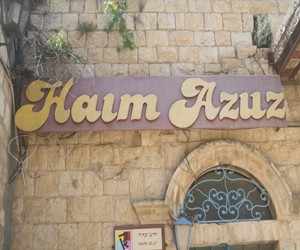Haim Azuz
Sculpturing in Tzfat
In an artists' community that was once limited to painters, sculptors have had a difficult time finding a niche in Tzfat's Artists' Quarter. Moshe Ziffer was, for the formative years of the Artists Colony, the only sculptor. He created figurative sculptures which today not only adorn historic and educational sites throughout Israel, but also make up the beautiful Ziffer Garden of Tzfat, the garden of the house where he worked and exhibited during the heyday of the Artists Quarter in the 50s, 60s, and 70s.
During his working career in Tzfat, Ziffer became a teacher and mentor to several new young sculptors, among them, Haim Azuz. Azuz was born in Turkey and began sculpting at age 14, slowly teaching himself the techniques of bronze and aluminum sculpting. When Azuz arrived in Tzfat in 1971, he came to the attention of Ziffer, who guided and mentored Azuz as he began to refine his technique and develop the flowing style for which he is known today.
Haim Azuz's gallery sits in a small corner of the Artists Colony, on Tet Vav Street, directly across from the Ma'ayan HaRadum public square. It is not an easy gallery to find, or a particularly commercial one - visitors generally search out the Azuz gallery because of the reputation of the artist, or wander in because it's off the beaten path away from Tzfat's "Gallery Row". In the Azuz gallery they know that they'll be able to view unique and tasteful art in a non-pressured environment. In fact, one of the delights of a visit to Azuz's gallery, visitors note, is that he allows visitors to wander around and enjoy his sculptures, explains the sculptures when asked, and never pressures anyone to buy anything.
Tzfat Landmarks
Haim Azuz's sculptures are featured in many of Tzfat's public spaces, where they are available for Tzfat residents to see and enjoy. "The Flower", a 16-foot bronze sculpture, is probably one of Tzfat's best-known, as it sits outside of the Tzfat Cultural Center, Beit Yigal Alon. Generations of Tzfat residents have viewed and admired this piece, most never knowing much about the artist, but recognizing that its presence strengthens the reputation of Tzfat as a city where art is appreciated and understood.
In addition to The Flower, Tzfat's General Artists' Exhibition features an aluminum sculpture of Azuz's, The Burning Bush. Aside from this piece, inspired by the Biblical story of Moses speaking to God at the Burning Bush, most of Azuz's works are not particularly Jewish nor Biblical. He explores the human figure in such works as The Torso, Love, The Dancer, and Belly Dance, and human emotions in works like Consolation, Reflective Ness and The Dream.
Perhaps, however, the Azuz sculpture that most people enjoy sits at the entrance to the General Exhibition of the Artists Quarter. Titled "Adam and Eve" it shows two figures standing back-to-back, heads hung in desolation, with a half-eaten apple between them. For some reason, the message in this sculpture speaks to all.
Haim Azuz's gallery sits in a small corner of the Artists Colony, on Tet Vav Street, directly across from the Ma'ayan HaRadum public square.

